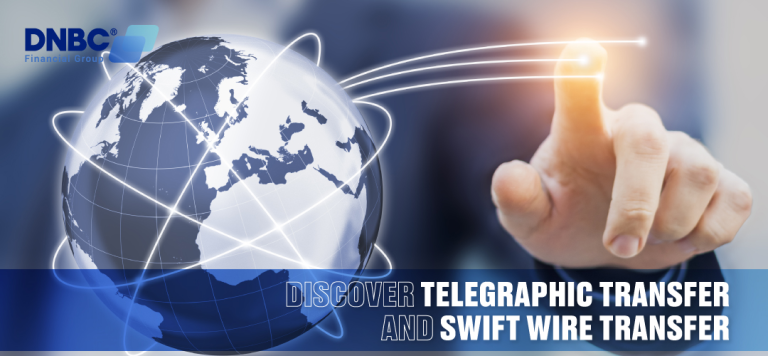When dealing with international transfer, you will come across many different terms. Typically, two of them are telegraphic transfer and swift wire transfer.
They can be rather confusing for any new customers making domestic and international transfers.
It’s necessary to initiate money transfers for several reasons such as sending for business purposes abroad or sending money to your relatives overseas.
When it comes to those terms, we’ll go through every detail of telegraphic transfer and swift wire transfer in this article.
What is a telegraphic transfer?
In the 1900s, Telegraphic transfer was applied in international money transfers. This is the earliest manner of an electronic money transfer way to transfer money between banks.

Discover telegraphic transfer and Swift wire transfer
In greater detail, a telegraphic transfer referred to the transfer of money to another country using a telex, sending money via traditional cables, radios, or any telephone systems.
To send money via a telegraphic transfer, you will use the SWIFT network. This means it’s required to have a SWIFT/BIC (bank identifier code) of the SWIFT member bank that you intend to send funds to.
(Ps: SWIFT stands for Society for Worldwide Interbank Financial Telecommunication. SWIFT is a member-owned network of banks and financial organizations for international transfers. Only SWIFT member banks or institutions can apply this network to send funds between countries.)
You will need the bank account details, the beneficiary’s name, IBAN (For a European account, receiving bank address, and choose who is responsible for the fees involved)
In fact, a telegraphic transfer and a wire transfer are 2 forms of electronic funds transfer.
Electronic funds transfer is used for the transfer of funds electronically. It can be transferred domestically, internationally, for online purchases, withdrawals, bank transfers, telephone instructed transfers or ATM transfers.
In addition, a telegraphic transfer and a wire transfer are a series of instructions, or a message about the details of a transaction through the corresponding network (SWIFT network, Western Union…).
The actual transfer of cash will usually take place after the message has been sent, processed, and cleared at the receiving bank. If the fund transfer goes through several banks, the time to receive money can take longer.
Nowadays, a telegraphic transfer can be used similarly to a wire transfer. Basically, the new electronic system replaced the old one in the wake of technological and electronic development.
Therefore, when you hear about a telegraphic transfer, that means a wire transfer.
What is a Swift wire transfer?
Wire transfer is a perfect method for international money transfers. This can be between individuals or entities and across a network of banks or an online money transfer provider.
SWIFT networks can be applied in many cases, but there are different wire transfer providers with their own network to support wire transfers.
There are two types of wire transfers: domestic wire transfer & international wire transfer.
Domestic Wire Transfer
This method is used for countries with their own network setup. This helps to move money between domestic institutions faster and more cost-effectively.
You just need to provide some basic personal information, local bank details to set up for an internal fund transfer. Each country has their own domestic banking system to make sending money quickly and easily.
International Wire Transfer
If you plan to send money to your relatives or friend internationally, then you can use a third party provider to send your international wire transfer.
This can be the fastest way to move funds from one country to another in a secure manner.
International wire transfers are an international standard known as the SWIFT network. Unlike the name suggested, SWIFT transfers can be at slow speed.
The financial institution allows money to travel between banks internationally with a unique identifier code to make sure your transfer gets to the right beneficiary.
At present, SWIFT has more than 11,000 member banks and financial institutions, in 200 countries to make it the biggest interconnected bank network globally.
Every entity in the SWIFT network has a different code (from 8 to 11 characters long). This is known as BIC (bank identifier code) or SWIFT ID.
Here are some considerations of a wire transfer as your suitable option.
You can send money overseas urgently and your fund will be processed instantly.
Your relatives overseas don’t need to access a bank account.
Your local banks don’t support international transfers.
Wire transfer uses the SWIFT network to transfer money from one country to the other. It can take about 5 business days for the beneficiary to receive money. Charges for wire transfer vary from bank to bank and depend on the transfer funds.
To make a wire transfer, you need to know whether it is domestic or international. It also depends on a specific bank, third party network provider and final destination.
You’re required to provide the name, account details, sending amount, and pickup location for cash pickups.
In conclusion, there is no big difference between telegraphic transfers and wire transfers. Thus, if you visit a bank and ask them to transfer funds abroad, they won’t differentiate between telegraphic transfers and wire transfers because the two terms are similar.
Information about DNBC Financial Group
DNBC Financial Group strives to boost the best business account for international payments with wire transfers in the wake of technological and electronic advancement.
DNBC Financial Group offers full online payment solutions, money transactions in over 173 countries with multiple currencies, being transparent and fast delivery speed. DNBC Financial group is always willing to support you 24/7.
Or please contact DNBC
![]() Email: [email protected]
Email: [email protected]
![]() Phone Number:
Phone Number:
- +65 6572 8885 (Office)
- +1 604 227 7007 (Hotline Canada)
- +65 8442 3474 (WhatsApp)



 DNBC Team
DNBC Team